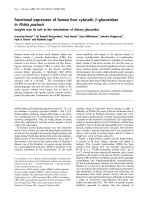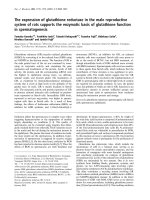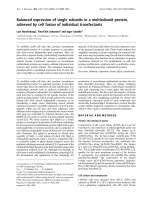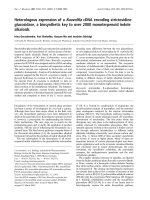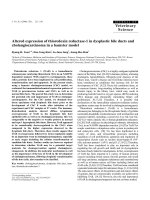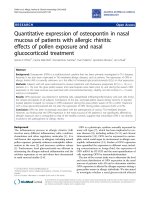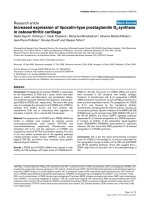Báo cáo y học: "Altered expression of inflammatory cytokines in primary osteoarthritis by human T lymphotropic virus type I retrovirus infection: a cross-sectional study" pps
Bạn đang xem bản rút gọn của tài liệu. Xem và tải ngay bản đầy đủ của tài liệu tại đây (332.32 KB, 8 trang )
Open Access
Available online />R347
Vol 6 No 4
Research article
Altered expression of inflammatory cytokines in primary
osteoarthritis by human T lymphotropic virus type I retrovirus
infection: a cross-sectional study
Yoshiki Yoshihara
1
, Tomoo Tsukazaki
1
, Makoto Osaki
1
, Masahiro Nakashima
2
, Kazuhisa Hasui
3
and
Hiroyuki Shindo
1
1
Division of Orthopaedic Pathomechanism, Department of Developmental and Reconstructive Medicine, Nagasaki University Graduate School of
Biomedical Sciences, Nagasaki, Japan
2
Tissue and Histopathology Section, Atomic Bomb Disease Institute, Nagasaki University Graduate School of Biomedical Sciences, Nagasaki, Japan
3
Department of Immunology, Course of Infection and Immunity, Course of Health Science, Kagoshima University Graduate School of Medical and
Dental Sciences, Kagoshima, Japan
Corresponding author: Tomoo Tsukazaki,
Received: 18 Mar 2004 Revisions requested: 8 Apr 2004 Revisions received: 19 Apr 2004 Accepted: 7 May 2004 Published: 7 Jun 2004
Arthritis Res Ther 2004, 6:R347-R354 (DOI 10.1186/ar1193)
http://arthr itis-research.com/conte nt/6/4/R347
© 2004 Yoshihara et al.; licensee BioMed Central Ltd. This is an Open Access article: verbatim copying and redistribution of this article are permitted
in all media for any purpose, provided this notice is preserved along with the article's original URL.
Abstract
Human T cell leukaemia virus type I (HTLV-I) is known to be
involved in late-onset chronic polyarthritis as HTLV-I-associated
arthropathy. However, it is unclear whether HTLV-I infection
could modify the pathophysiology of osteoarthritis (OA). In this
study we compared several inflammatory cytokines, such as C-
terminal parathyroid hormone-related peptide (C-PTHrP),
soluble interleukin-2 receptor (sIL-2R) and interleukin (IL)-6, and
an osteo-destruction marker, deoxypyridinoline, in synovial fluid
(SF) samples obtained from 22 HTLV-I carriers and 58 control
non-carrier patients with OA. These patients were diagnosed
clinically and radiographically with primary OA affecting one or
both knee joints, and were similar with regard to age, sex and
clinical symptoms. We also performed histopathological
examination as well as immunohistochemistry of HTLV-I-derived
Tax protein in eight synovial tissues taken from carrier patients.
C-PTHrP in SF was significantly higher in HTLV-I carriers (287
± 280 pM) than in non-carriers (69 ± 34 pM), and the
concentration in 13 carriers was above the upper range of OA.
In HTLV-I carriers, the concentrations of sIL-2R (741 ± 530 IU/
ml), IL-6 (55 ± 86 ng/ml) and deoxypyridinoline (3.1 ± 1.8 nM)
were higher than in non-carriers (299 ± 303, 2.5 ± 4.0, 0.96 ±
1.0, respectively), and correlated positively with C-PTHrP. C-
PTHrP, sIL-2R and IL-6 concentrations in SF positive for IgM
antibody against HTLV-I antigen, a marker of persistent viral
replication, were higher than of IgM-negative SF. Histologically,
five and two synovia showed mild and moderate synovial
proliferation with or without some degree of inflammatory
reaction, respectively, and could not be distinguished from OA.
Tax-positive synoviocytes were observed sparsely in all samples,
and often appeared frequently in actively proliferating regions.
Our results suggest that although HTLV-I infection does not
necessarily worsen the clinical outcome and local synovitis, the
virus can potentially modify the pathophysiology of OA by
increasing the inflammatory activity in a subset of carrier
patients, especially those with IgM antibody. Longitudinal
studies are required to assess the association between HTLV-I
infection and OA.
Keywords: Human T cell leukaemia virus type I, osteoarthritis, parathyroid hormone-related peptide, synovial fluid, Tax
Introduction
Retroviral infection is associated with various pathological
conditions, including several cancers and immunological
and neurological disorders [1]. Human T cell leukaemia
virus type I (HTLV-I) is the causative virus of acute T-cell
leukaemia (ATL) [2]. HTLV-I is estimated to infect more
than 10 million people worldwide, and is endemic in several
areas including southwestern Japan, especially in Kyusyu
Island. Although most seropositive individuals are asympto-
matic carriers, a proportion of these individuals develop
ATL in adolescence. In addition, HTLV-I has also been
shown to be involved in several immunological and inflam-
ATL = acute T-cell leukaemia; C-PTHrP = C-terminal parathyroid hormone; DPD = deoxypyridinoline; HAAP = HTLV-I-associated arthropathy; HTLV-
I = human T lymphotropic virus type I; IL-6 = interleukin-6; OA = osteoarthritis; RA = rheumatoid arthritis; SF = synovial fluid; sIL-2R = soluble inter-
leukin-2 receptor.
Arthritis Research & Therapy Vol 6 No 4 Yoshihara et al.
R348
matory disorders, such as HTLV-I-associated myelopathy/
tropical spastic paraparesis, bronchopneumonopathy, Sjö-
gren syndrome and uveitis [3,4].
HTLV-I-associated arthropathy (HAAP) is also recognized
as chronic arthritis caused by HTLV-I infection. In 1989,
Nishioka and colleagues [5] reported 11 HTLV-I carriers
with chronic oligoarthritis associated with ATL-like lym-
phocyte infiltration. The onset of HAAP often starts acutely
in a relatively large joint such as the knee, wrist or shoulder,
and the associated symptoms closely resemble those of
rheumatoid arthritis (RA). The histopathological changes in
HAAP include marked proliferation of synoviocytes in the
synovial lining layer, gross infiltration of lymphocytes, and
migration of atypical lymphocytes with nuclear indentation
into the synovial fluid (SF) and/or synovial tissue.
Numerous studies have demonstrated that HTLV-I can alter
the oncogenic and immunogenic properties of synovial
cells and lymphocytes [6,7]. In addition, mice overexpress-
ing Tax, the protein encoded by the HTLV-I pX region,
develop RA-like chronic and systemic synovitis [8]. Further-
more, epidemiological studies have revealed a significant
association of HTLV-I infection and RA in endemic areas in
Japan [9,10], although studies in the USA, Europe and
South Africa failed to link HTLV-I infection and RA [11-14].
These pieces of evidence link HTLV-I infection to synovial
proliferation; however, several clinical issues remain unre-
solved. There is still no established criterion for the diagno-
sis of HAAP because of the lack of specific symptoms and/
or laboratory markers. Moreover, it is also not clear whether
HAAP could exhibit other phenotypes, such as monoarthri-
tis instead of polyarthritis.
Osteoarthritis (OA) is a degenerative disorder caused by
mechanical overload and/or a consequence of imbalanced
biological events between cartilage degradation and syn-
thesis [15]. In primary OA, age, obesity and malalignment
are known as predisposing factors, but the association of
virus infection has not yet been studied. In the present
study we investigated a potential role of HTLV-I infection in
the pathophysiology of primary OA. For this, we compared
the concentrations of several inflammatory cytokines in SF
taken from HTLV-I carriers and non-carrier patients who
had been diagnosed with primary OA of one or both knee
joints. We also studied the histopathological features of
synovia of eight HTLV-I carrier patients, and determined the
expression of Tax protein by immunohistochemistry.
Materials and methods
Patients and samples
Outpatients fulfilling the criteria of the American College of
Rheumatology for the diagnosis of knee OA [16] and cor-
responding to OA grade II or higher by the radiographic cri-
teria of Kellgren and Lawrence [17] were recruited to this
cross-sectional study. Patients who fulfilled even one of the
American College of Rheumatology criteria for RA during
the later 4-year observation period were excluded. Patients
with secondary arthritis, such as gout, pseudogout, puru-
lent or traumatic arthritis or seronegative arthritis, were also
excluded.
Peripheral blood and SF samples were obtained simultane-
ously from 22 HTLV-I carrier outpatients at the initial exam-
ination and were subjected to appropriate pretreatment as
described previously [18]. As patient control, SF and
serum were also obtained from 58 HTLV-I-negative OA
patients. Comparison of HTLV-I carrier and non-carrier OA
patients showed no obvious differences in age, sex,
affected side and disease duration (Table 1). At the initial
examination, 20 HTLV-I carriers and 55 non-carrier patients
felt pain in the medial femorotibial joints, a common type in
Japanese primary OA, whereas the remaining patients also
complained of pain in the patellofemoral joint. Joint swell-
ing, repeated hydrops and limited range of motion were
also commonly observed in the enrolled patients, without
obvious differences between HTLV-I carriers and non-car-
riers. The major radiographic findings in the 80 patients
were osteophyte formation with or without narrowing of the
joint space and sclerotic change of subchondral bone, and
there was no significant difference in these radiographic
features between HTLV-I carriers and non-carriers as
defined by the Kellgren/Lawrence scoring method (Table
1). At the time of enrolment in the present study, patients
were taking a variety of medications, including non-steroi-
dal anti-inflammatory drugs, external splints and intra-artic-
ular injections of prednisone and/or hyaluronic acid.
Intra-articular injection was discontinued for at least 2
weeks before sample collection. The erythrocyte sedimen-
tation rate, serum C-reactive protein and serum calcium
concentrations were confirmed to be within the normal
range in all patients. The study protocol was approved by
the Human Ethics Review Committee of Nagasaki Univer-
sity School of Medicine, and a signed consent form was
obtained from each subject.
ELISA and Western blotting of HTLV-I
Anti-HTLV-I antibody in sera and SF was screened by
enzyme-linked immunosorbent assay (ELISA; Eitest-ATL
kit; Eisai Inc., Tokyo, Japan) in accordance with the instruc-
tions provided by the manufacturer. This ELISA system is
designed to detect IgG antibody. On the basis of this test,
22 patients with immunoreactivity in both serum and SF
samples were defined as HTLV-I carriers.
To determine the epitope recognized by the antibody and
to characterize the specificity of IgG and IgM antibodies,
SF was subjected to Western blot analysis with the use of
epitope-transferred membrane (Eitest-ATL WB kit; Eisai
Available online />R349
Inc.). Two envelope proteins and three core proteins
derived from HTLV-I were fixed onto nitrocellulose mem-
brane, and specific binding of IgG or IgM was distin-
guished by specific secondary antibody. The result of the
Western blot was defined as positive when each antibody
reacted with at least two antigens. In this Western blot
analysis, IgG antibody was present in all 22 examined SF,
whereas IgM class antibody, which is considered to be ele-
vated in the acute phase of active viral replication [19], was
detected in the SF of 8 carriers (Table 1). There was no dif-
ference in age, sex or disease duration between carrier
patients with or without IgM antibody.
Measurements of C-terminal parathyroid hormone, sIL-
2R, IL-6, chondrocalcin and deoxypyridinoline
The C-terminal region (amino acids 109–141) of parathy-
roid hormone-related peptide (C-PTHrP) was measured
with a radioimmunoassay kit (Daiichi Radioisotopes Labo-
ratory, Chiba, Japan) as described previously [18]. Soluble
interleukin (IL)-2 receptor (sIL-2R) (Endogen Inc., Woburn,
MA), IL-6 (Endogen Inc.), chondrocalcin (Teijin Co., Tokyo,
Japan) and deoxypyridinoline (DPD) (PYRLINKS-D; Quidel
Corporation, Santa Clara, CA) were determined by ELISA
with the protocol recommended by each manufacturer.
Tissue samples and immunohistochemistry
The synovial tissues were obtained at the time of joint
replacement surgery (n = 4), synovectomy (n = 2) or high
tibial osteotomy (n = 2) from HTLV-I carriers, and subjected
to routine histopathological and immunohistochemical
examinations as described previously [20]. In brief, depar-
affinized serial sections were preincubated with 3% H
2
O
2
to remove endogenous peroxidase activity, and then incu-
bated overnight at 4°C with monoclonal anti-HTLV-I Tax
antigen (Lt-4, a gift from Dr Tanaka) antibody [21]. The pro-
tein expression was detected by the ImmunoMax/catalyzed
signal amplification method with 3,3-diaminobenzidine tet-
rahydrochloride as a substrate [22]. The preparation incu-
bated without the primary antibody served as the control. In
accordance with our previous methods [20], the degree of
proliferation of synovial lining cells was assessed in at least
five points in an area of more than 1.5 cm × 1.5 cm as fol-
lows: -, 1 or 2 cells thick; +/-, 3 or 4 cells thick; ++, 5–9
cells thick; +++, more than 10 cells thick. The overall
degree of inflammatory reaction was also semi-quantified
as follows: -, no infiltration; +/-, minimal and partial infiltra-
tion; +, moderately diffuse or aggregated infiltration; ++,
large number of aggregates, many demonstrating germinal
centres. These histological findings were evaluated inde-
pendently by two authors (TT and MN).
Statistical analysis
Data are expressed as means ± SD. Mann–Whitney test
and χ
2
test with Yates's correction were used to compare
data from two or three groups. Correlation coefficients
were determined by Pearson linear regression analysis. P <
0.05 was considered significant.
Results
C-PTHrP in sera and SF
To investigate whether a distinct pathological state exists in
HTLV-I-infected arthritis, we measured the concentrations
of several inflammatory cytokines in SF from HTLV-I carrier
and non-carrier OA patients. We have previously demon-
strated that whereas C-PTHrP in SF of OA patients is
within the low concentration of normal SF, C-PTHrP con-
centration in RA markedly increased with the severity of dis-
ease activity [18]. Consistent with the previous findings
were our results that C-PTHrP concentrations in sera of
HTLV-I carrier and non-carrier OA patients were low, rang-
ing from 16 to 60 pM (carriers, 22 ± 12; non-carriers, 26 ±
16 pM; P > 0.05). In contrast, SF C-PTHrP in HTLV-I car-
riers (287 ± 280, range 19–955 pM) was significantly
higher than in non-carrier OA patients (69 ± 34, range 22–
Table 1
Clinical and radiographic background of human T lymphotropic virus type I carriers and non-carriers
Parameter HTLV-I carriers HTLV-I non-carriers
IgM Ab
+
IgM Ab
-
Number of patients 8 14 58
Age (years)
a
68.8 (58–78) 72.0 (56–87) 68.6 (51–88)
Sex (M/F) 3/5 4/10 16/42
Disease duration (years)
a
7.8 (4–15) 6.6 (4–10) 6.3 (3–13)
Unilateral/bilateral 2/6 5/9 17/41
K/L scale
b
(II/III/IV) 7/5/2 10/10/3 49/42/8
a
Data are means (range); all other data are numbers of patients or affected joints.
b
Scoring was as follows: II, minimal osteophytes possibly with
narrowing, cyst and sclerosis; III, moderate or definite osteophytes with moderate joint space narrowing; IV, severe with large osteophytes and
definite joint space narrowing. Disease duration indicates the period from the first affected joint in cases with bilateral knee arthritis. Ab, antibody;
F, female; HTLV-I, human T lymphotropic virus type I; K/L, Kellgren/Lawrence; M, male.
Arthritis Research & Therapy Vol 6 No 4 Yoshihara et al.
R350
134 pM; P < 0.001) (Fig. 1). Furthermore, C-PTHrP was
significantly higher in IgM-positive (494 ± 296, range 37–
955; n = 8) than in IgM-negative (169 ± 195, range 19–
644 pM; P = 0.006) HTLV-I carriers.
sIL-2R, IL-6, chondrocalcin and DPD in SF
We also evaluated sIL-2R and IL-6, which are known to
increase in SF of inflammatory arthritis [23,24]. Both sIL-2R
and IL-6 in SF of HTLV-I carriers (respectively 741 ± 530
IU/ml, range 211–1970, and 55 ± 86 ng/ml, range 0–333)
were significantly higher than those of HTLV-I-negative OA
patients (299 ± 303 IU/ml, range 0–1510, and 2.5 ± 4.0
ng/ml, range 0.1–13.9; P < 0.001 and P < 0.05, respec-
tively). Furthermore, sIL-2R in IgM-positive carriers (1190 ±
556 IU/ml, range 493–1970) was also significantly higher
than in IgM-negative carriers (440 ± 202 IU/ml, range
211–802; P < 0.001).
Concentrations of chondrocalcin (a marker of articular car-
tilage damage) and DPD (a marker of subchondral bone
absorption) [25,26] were also examined in these samples.
Although there was no significant difference in chondrocal-
cin concentration between carriers (3.0 ± 4.0 ng/ml, range
0–16.3) and non-carrier OA patients (3.3 ± 1.9 ng/ml,
range 0–7.9; P = 0.75), DPD in HTLV-I carriers (3.1 ± 1.8
nM, range 0–6.8) was significantly higher than in non-car-
rier OA patients (0.96 ± 1.0 nM, range 0–3.6; P < 0.001).
To test whether the elevated C-PTHrP in SF reflected joint
inflammation, the relationship between C-PTHrP and the
above markers was examined in SF of HTLV-I carriers. C-
PTHrP was positively correlated with sIL-2R (r = 0.54, P =
0.01), IL-6 (r = 0.57, P = 0.001) and DPD (r = 0.60, P =
0.003) (Fig. 2).
Histopathological and immunohistochemical
examination for HTLV-I Tax
In eight synovial tissues obtained from HTLV-I carriers, six
samples, including two IgM-positive carriers, showed his-
topathological features that are often observed in late-
stage OA: synovial lining cells were stratified into only a few
layers, and inflammatory reaction was subtle or minimal
(Table 2). In contrast, the two synovia of IgM-positive
patients consisted, in part, of papillary projected synovium
with synovial lining cells stratified into more than five layers
(Fig. 3a). Unlike RA, however, lymphocyte infiltration was
focal and not significant, and the infiltrating lymphocytes
never formed lymphoid follicles in the interstitium. There
was no apparent relationship between histopathological
findings, radiographic exacerbation and the concentration
of each cytokine.
Immunohistochemistry demonstrated that Tax was
expressed and that the number of Tax-positive cells varied
in the samples (Fig. 3b). Although there was no correlation
between Tax immunoreactivity and level of inflammation,
the papillary projected region of IgM-positive carriers
tended to contain a higher number of Tax-positive
synoviocytes.
Discussion
In the present study we compared the concentrations of
several inflammatory cytokines in SF between HTLV-I car-
rier patients and HTLV-I-negative OA patients. By investi-
gating OA patients only and excluding those with RA, we
were able to demonstrate the involvement of HTLV-I infec-
tion in arthritis. Our results showed that C-PTHrP, sIL-2R
and IL-6 were significantly higher in SF of HTLV-I carriers
than in that of HTLV-I-negative OA patients. Furthermore,
the concentrations of increased markers were higher in
HTLV-I carriers positive for IgM antibody than those nega-
tive for the antibody. These results indicate that the joint
inflammation is more severe in HTLV-I carriers than in
HTLV-I-negative OA patients. However, we were unable to
identify any differences in radiographic findings between
the two groups. It is possible that the pathological changes
in our carrier patients are under the limit of detection by the
Kellgren scaling system, which addresses only the radio-
graphic dimensions of arthritis. Alternatively, HTLV-I-asso-
ciated arthritis might be only slowly progressive after onset,
and the changes in disease status over a few years are
often small and difficult to quantify.
Figure 1
C-terminal parathyroid hormone (C-PTHrP) concentrations in synovial fluid samples of human T lymphotropic virus type I (HTLV-I) carrier patients and non-carrier patients with osteoarthritisC-terminal parathyroid hormone (C-PTHrP) concentrations in synovial
fluid samples of human T lymphotropic virus type I (HTLV-I) carrier
patients and non-carrier patients with osteoarthritis. Synovial fluids
were obtained from knee joints of HTLV-I carriers (n = 22) and non-car-
riers (n = 58) with primary osteoarthritis. The concentration of C-termi-
nal (104–141) PTHrP was measured by radioimmunoassay. Filled
circles, IgM-positive HTLV-I carriers; triangles and bars, means ± SD.
Available online />R351
With regard to the mechanism of HTLV-I infection-induced
changes in immunogenic properties, previous studies
reported that PTHrP, IL-2 receptor α subunit and IL-6 are
cellular target genes of the Tax protein [27-29]. In particu-
lar, direct binding of Tax to the nuclear factor-κB sequence
on the IL-6 promoter is important for HTLV-I-induced IL-6
secretion in cultured synoviocytes [30]. In our study we
used immunohistochemistry to examine the expression of
the Tax protein and showed the expression of Tax in synovi-
ocytes in all samples examined. Although Tax expression
was not correlated with cytokine concentration in SF, prob-
ably owing to the time discrepancy between SF aspiration
and tissue preparation, Tax expression in synoviocytes
might be responsible, at least in part, for the increased con-
centrations of PTHrP, sIL-2R and IL-6 in SF of carrier
patients.
Figure 2
Correlation between C-terminal parathyroid hormone (C-PTHrP) con-centrations and (a) soluble IL-2 receptor (sIL-2R), (b) IL-6 and (c) deox-ypyridinoline (DPD) in synovial fluid samples of human T lymphotropic virus type I (HTLV-I) carriers with osteoarthritisCorrelation between C-terminal parathyroid hormone (C-PTHrP) con-
centrations and (a) soluble IL-2 receptor (sIL-2R), (b) IL-6 and (c) deox-
ypyridinoline (DPD) in synovial fluid samples of human T lymphotropic
virus type I (HTLV-I) carriers with osteoarthritis. The concentrations of
sIL-2R, IL-6 and DPD were measured by enzyme-linked immunosorbent
assay. Filled circles, IgM-positive HTLV-I carriers; open circles, IgM-
negative HTLV-I carriers.
Figure 3
(a) Histopathological features and (b) immunohistochemical expression of Tax protein in synovial tissue obtained from a representative human T lymphotropic virus type I (HTLV-I) carrier with osteoarthritis (case 6)(a) Histopathological features and (b) immunohistochemical expression
of Tax protein in synovial tissue obtained from a representative human T
lymphotropic virus type I (HTLV-I) carrier with osteoarthritis (case 6).
The synovium showed focal papillary proliferation together with hyper-
aemic dilated vessels and mild lymphocytic infiltration. Unlike in rheuma-
toid arthritis, however, neither stratified synovial lining cells nor
lymphoid follicle formation were evident throughout the whole tissue.
Tax-positive synoviocytes could be sparsely observed in the papillary
projected area of the synovium. Scale bar, 100 µm.
Arthritis Research & Therapy Vol 6 No 4 Yoshihara et al.
R352
Of the cytokines examined in our study, C-PTHrP behaved
as a unique marker for HTLV-I carrier patients. PTHrP was
first identified as a causative peptide of humoral
hypercalcaemia of malignancy in ATL patients [31]. How-
ever, it is currently recognized that PTHrP is produced by
many tissues and is involved in a variety of biological func-
tions by binding to PTH/PTHrP receptor [32]. In RA, PTHrP
is expressed in the proliferated synovium and such expres-
sion is correlated with the inflammatory activity [18,33].
PTHrP seems to act as a crucial mediator for inflammatory
arthritis [34]. We previously demonstrated that PTHrP was
also expressed in articular chondrocytes [35], and treat-
ment of cultured chondrocytes with PTHrP inhibited
chondrocyte differentiation [36]. Although the functional
role of PTHrP in our carrier patients remains obscure,
together with positive correlation of C-PTHrP with DPD,
which is a marker for bone destruction, it is likely that
PTHrP is also important in the degenerative process of the
subchondral bone. Moreover, C-PTHrP in 13 carriers was
elevated above the upper concentration in OA patients,
indicating that C-PTHrP could be a potential marker of
HTLV-I-associated arthritis, allowing it to be distinguished
from primary OA. It should be noted here that the concen-
trations of C-PTHrP in our carrier patients were much lower
than those in RA patients [18], and were not correlated
with erythrocyte sedimentation rate or C-reactive protein,
suggesting that the mechanism(s) involved in the activation
of PTHrP in HTLV-I associated monoarthritis differ from that
of RA.
The histopathological features of HAAP are thought to be
indistinguishable from RA [5]. Despite the small number of
patients in the present study, the synovia obtained from
HTLV-I-infected patients showed relatively low inflamma-
tory reaction and synovial proliferation, which could have
been diagnosed as primary OA rather than RA. That syno-
via taken by synovectomy tended to accompany intense
synovitis compared with others might be a result of the rel-
atively short interval from onset to tissue preparation (aver-
age 0.9 versus 2.2 years; Table 2). Together with the
relatively low expression of inflammatory cytokines com-
pared with RA and no apparent differences in radiographic
findings between HTLV-I carriers and non-carriers, we
consider that the principal pathological features in the
HTLV-I-infected synovia are equivalent to those of OA. Fur-
ther studies with larger samples of synovial tissues are nec-
essary to validate our hypothesis.
Taken together, our results suggest that HTLV-I infection
can alter the pathophysiology of OA by increasing the
expression of inflammatory cytokines, but this modification
does not necessarily overcome the clinical outcome of sim-
ple OA except for IgM-positive patients, who could suffer
from more severe symptoms as a result of the activated
inflammation. Moreover, it is possible that the altered
inflammatory activity is partial and transient during the nat-
ural course of OA and does not continue to the final stage.
In contrast to the development of systemic arthritis in Tax
transgenic mice [8], we consider that HTLV-I infection
alone is not sufficient to cause the development of monoar-
thritis independently of OA. Further studies including the
incidence of HTLV-I-modulated primary OA in seropositive
patients, in addition to longitudinal studies, are required to
enhance our understanding of the association between
HTLV-I infection and arthritis.
Table 2
C-terminal parathyroid hormone (C-PTHrP) concentration, radiographic changes, histopathological features and Tax expression in
synovia of human T lymphotropic virus type Icarriers with knee-joint osteoarthritis
Case IgM C-PTHrP (pM) Operation Kellgren/Lawrence scale
a
Interval (years) Synovial
proliferation
Inflammatory
reaction
Tax expression
b
Initial Before operation
1 + 201 OST IV IV 3.4 +/- - +/-
2-154 TA IVIV 2.8 + - +
3-214 TA IVIV 1.2 + +/- +
4+439 TA IVIV 3.5 + +/- ++
5-567 OST IIIIV 2.1 + +/- +
6 + 813 SYV II III 1.5 ++ + ++
7+955 SYV IIIIII 0.3 ++ + +
8-644 TA IVIV 0.5 + +/- +
The degrees of synovial proliferation and inflammatory reaction were semi-quantified as described in Materials and methods.
a
Scoring was as
follows: II, minimal osteophytes possibly with narrowing, cyst and sclerosis; III, moderate or definite osteophytes with moderate joint space
narrowing; IV, severe with large osteophytes and definite joint space narrowing.
b
Scoring was as follows: +/-, minimum staining in one area of the
tissue; +, patchy staining involving several areas; ++, moderate diffuse staining. OST, osteotomy; SYV, synovectomy; TA, total joint arthroplasty.
Available online />R353
Conclusions
The present study indicates that HTLV-I infection could
modify the inflammatory activity of ordinary primary OA,
whereby direct activation by Tax protein might account for
the increased concentrations of PTHrP, sIL-2R, IL-6 and
DPD in SF. Our results also suggest that C-PTHrP could
be a potential marker to distinguish HTLV-I-associated OA
from simple primary OA in carrier patients.
Competing interests
None declared.
References
1. Masuko-Hongo K, Kato T, Nishioka K: Virus-associated arthritis.
Best Pract Res Clin Rheumatol 2003, 17:309-318.
2. Hinuma Y, Nagata K, Hanaoka M, Nakai M, Matsumoto T, Kinoshita
KI, Shirakawa S, Miyoshi I: Adult T-cell leukemia: antigen in an
ATL cell line and detection of antibodies to the antigen in
human sera. Proc Natl Acad Sci USA 1981, 78:6476-6480.
3. Zucker-Franklin D: Non-HIV retroviral associations with rheu-
matic disease. Curr Rheumatol Rep 2000, 2:156-162.
4. Barmak K, Harhaj E, Grant C, Alefantis T, Wigdahl B: Human T
cell leukemia virus type I-induced disease: pathways to cancer
and neurodegeneration. Virology 2003, 278:1-12.
5. Nishioka K, Maruyama I, Sato K, Kitajima I, Nakajima Y, Osame M:
Chronic inflammatory arthropathy associated with HTLV-I.
Lancet 1989, i:441.
6. Yin W, Hasunuma T, Kobata T, Sumida T, Nishioka K: Synovial
hyperplasia in HTLV-I associated arthropathy is induced by
tumor necrosis factor-alpha produced by HTLV-I infected
CD68+ cells. J Rheumatol 2000, 27:874-881.
7. Tsumuki H, Nakazawa M, Hasunuma T, Kobata T, Kato T, Uchida
A, Nishioka K: Infection of synoviocytes with HTLV-I induces
telomerase activity. Rheumatol Int 2001, 20:175-179.
8. Iwakura Y, Tosu M, Yoshida E, Takiguchi M, Sato K, Kitajima I,
Nishioka K, Yamamoto K, Takeda T, Hatanaka M, Yamamoto H,
Sekiguchi T: Induction of inflammatory arthropathy resembling
rheumatoid arthritis in mice transgenic for HTLV-I. Science
1991, 253:1026-1028.
9. Eguchi K, Origuchi T, Takashima H, Iwata K, Katamine S, Nagataki
S: High seroprevalence of anti-HTLV-I antibody in rheumatoid
arthritis. Arthritis Rheum 1996, 39:463-466.
10. Motokawa S, Hasunuma T, Tajima K, Krieg AM, Ito S, Iwasaki K,
Nishioka K: High prevalence of arthropathy in HTLV-I carriers
on a Japanese island. Ann Rheum Dis 1996, 55:193-195.
11. Bailer RT, Lazo A, Harisdangkul V, Ehrlich GD, Gray LS, Whisler
RL, Blakeslee JR: Lack of evidence for human T cell lympho-
trophic virus type I or II infection in patients with systemic
lupus erythematosus or rheumatoid arthritis. J Rheumatol
1994, 21:2217-2224.
12. di Giovine FS, Bailly S, Bootman J, Almond N, Duff GW: Absence
of lentiviral and human T cell leukemia viral sequences in
patients with rheumatoid arthritis. Arthritis Rheum 1994,
37:349-358.
13. Nelson PN, Lever AM, Bruckner FE, Isenberg DA, Kessaris N, Hay
FC: Polymerase chain reaction fails to incriminate exogenous
retroviruses HTLV-I and HIV-1 in rheumatological diseases
although a minority of sera cross react with retroviral antigens.
Ann Rheum Dis 1994, 53:749-754.
14. Sebastian D, Nayiager S, York DY, Mody GM: Lack of association
of Human T-cell lymphotrophic virus type 1 (HTLV-1) infection
and rheumatoid arthritis in an endemic area. Clin Rheumatol
2003, 22:30-32.
15. Fernandes JC, Martel-Pelletier J, Pelletier JP: The role of
cytokines in osteoarthritis pathophysiology. Biorheology 2002,
39:237-246.
16. Altman RD, Hochberg M, Murphy WA Jr, Wolfe F, Lequesne M:
Atlas of individual radiographic features in osteoarthritis. Oste-
oarthritis Cartilage 1995, 3(Suppl A):3-70.
17. Kellgren JH, Lawrence JS: Radiological assessment of osteo-
arthrosis. Ann Rheum Dis 1957, 16:494-502.
18. Okano K, Tsukazaki T, Ohtsuru A, Namba H, Osaki M, Iwasaki K,
Yamashita S: Parathyroid hormone-related peptide in synovial
fluid and disease activity of rheumatoid arthritis. Br J
Rheumatol 1996, 35:1056-1062.
19. Nagasato K, Nakamura T, Shirabe S, Shibayama K, Ohishi K, Ichi-
nose K, Tsujihata M, Nagataki S: Presence of serum anti-human
T-lymphotropic virus type I (HTLV-I) IgM antibodies means
persistent active replication of HTLV-I in HTLV-I-associated
myelopathy. J Neurol Sci 1991, 32:203-208.
20. Sugiyama M, Tsukazaki T, Yonekura A, Matsuzaki S, Yamashita S,
Iwasaki K: Localisation of apoptosis and expression of apopto-
sis related proteins in the synovium of patients with rheuma-
toid arthritis. Ann Rheum Dis 1996, 55:442-449.
21. Lee B, Tanaka Y, Tozawa H: Monoclonal antibody defining tax
protein of human T-cell leukemia virus type-I. Tohoku J Exp
Med 1989, 157:1-11.
22. Hasui K, Takatsuka T, Sakamoto R, Su L, Matsushita S, Tsuyama
S, Izumo S, Murata F: Improvement of supersensitive immuno-
histochemistry with an autostainer: a simplified catalysed sig-
nal amplification system. Histochem J 2002, 34:215-222.
23. Houssiau FA, Devogelaer JP, Van Damme J, de Deuxchaisnes CN,
Van Snick J: Interleukin-6 in synovial fluid and serum of
patients with rheumatoid arthritis and other inflammatory
arthritides. Arthritis Rheum 1988, 31:784-788.
24. Steiner G, Studnicka-Benke A, Witzmann G, Hofler E, Smolen J:
Soluble receptors for tumor necrosis factor and interleukin-2
in serum and synovial fluid of patients with rheumatoid arthri-
tis, reactive arthritis and osteoarthritis. J Rheumatol 1995,
22:406-412.
25. Mansson B, Carey D, Alini M, Ionescu M, Rosenberg LC, Poole
AR, Heinegard D, Saxne T: Cartilage and bone metabolism in
rheumatoid arthritis. Differences between rapid and slow pro-
gression of disease identified by serum markers of cartilage
metabolism. J Clin Invest 1995, 95:1071-1077.
26. Muller A, Hein G, Franke S, Herrmann D, Henzgen S, Roth A, Stein
G: Quantitative analysis of pyridinium crosslinks of collagen in
the synovial fluid of patients with rheumatoid arthritis using
high-performance liquid chromatography. Rheumatol Int 1996,
16:23-28.
27. Ruben S, Poteat H, Tan TH, Kawakami K, Roeder R, Haseltine W,
Rosen CA: Cellular transcription factors and regulation of IL-2
receptor gene expression by HTLV-I tax gene product. Science
1988, 241:89-92.
28. Dittmer J, Gitlin SD, Reid RL, Brady JN: Transactivation of the P2
promoter of parathyroid hormone-related protein by human T-
cell lymphotropic virus type I Tax1: evidence for the involve-
ment of transcription factor Ets1. J Virol 1993, 67:6087-6095.
29. Yamashita I, Katamine S, Moriuchi R, Nakamura Y, Miyamoto T,
Eguchi K, Nagataki S: Transactivation of the human interleukin-
6 gene by human T-lymphotropic virus type 1 Tax protein.
Blood 1994, 84:1573-1578.
30. Mori N, Shirakawa F, Abe M, Kamo Y, Koyama Y, Murakami S,
Shimizu H, Yamamoto K, Oda S, Eto S: Human T-cell leukemia
virus type I tax transactivates the interleukin-6 gene in human
rheumatoid synovial cells. J Rheumatol 1995, 22:2049-2054.
31. Ikeda K, Mangin M, Dreyer BE, Webb AC, Posillico JT, Stewart AF,
Bander NH, Weir EC, Insogna KL, Broadus AE: Identification of
transcripts encoding a parathyroid hormone-like peptide in
messenger RNAs from a variety of human and animal tumors
associated with humoral hypercalcemia of malignancy. J Clin
Invest 1988, 81:2010-2014.
32. Escande B, Lindner V, Massfelder T, Helwig JJ, Simeoni U: Devel-
opmental aspects of parathyroid hormone-related protein
biology. Semin Perinatol 2001, 25:76-84.
33. Funk JL, Cordaro LA, Wei H, Benjamin JB, Yocum DE: Synovium
as a source of increased amino-terminal parathyroid hor-
mone-related protein expression in rheumatoid arthritis. A
possible role for locally produced parathyroid hormone-
related protein in the pathogenesis of rheumatoid arthritis. J
Clin Invest 1998, 101:1362-1371.
34. Funk JL, Chen J, Downey KJ, Davee SM, Stafford G: Blockade of
parathyroid hormone-related protein prevents joint destruc-
tion and granuloma formation in streptococcal cell wall-
induced arthritis. Arthritis Rheum 2002, 48:1721-1731.
35. Tsukazaki T, Ohtsuru A, Enomoto H, Yano H, Motomura K, Ito M,
Namba H, Iwasaki K, Yamashita S: Expression of parathyroid
Arthritis Research & Therapy Vol 6 No 4 Yoshihara et al.
R354
hormone-related protein in rat articular cartilage. Calcif Tissue
Int 1995, 57:196-200.
36. Tsukazaki T, Ohtsuru A, Namba H, Oda J, Motomura K, Osaki M,
Kiriyama T, Iwasaki K, Yamashita S: Parathyroid hormone-
related protein (PTHrP) action in rat articular chondrocytes:
comparison of PTH(1–34), PTHrP(1–34), PTHrP(1–141),
PTHrP(100–114) and antisense oligonucleotides against
PTHrP. J Endocrinol 1995, 150:359-368.

